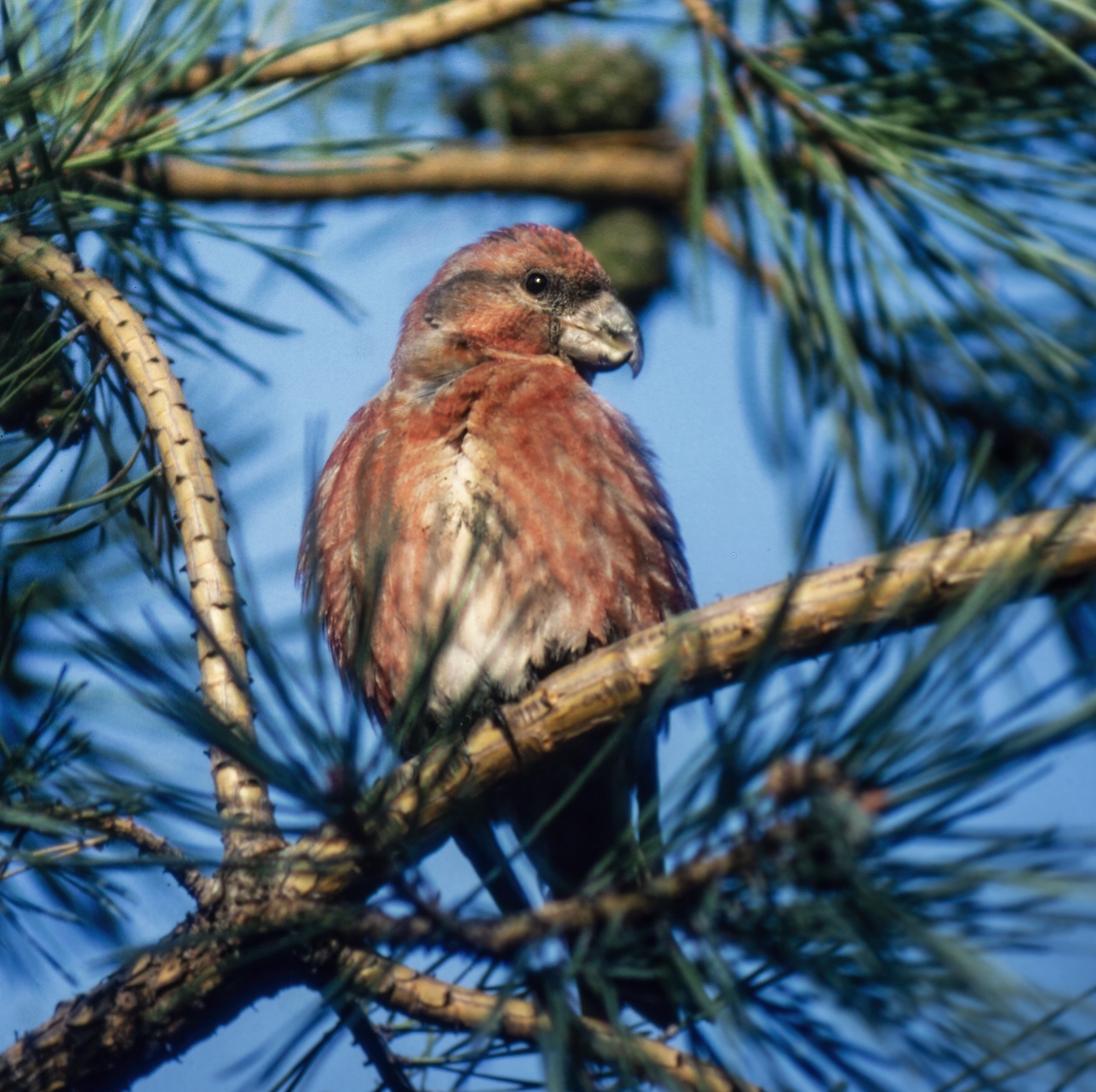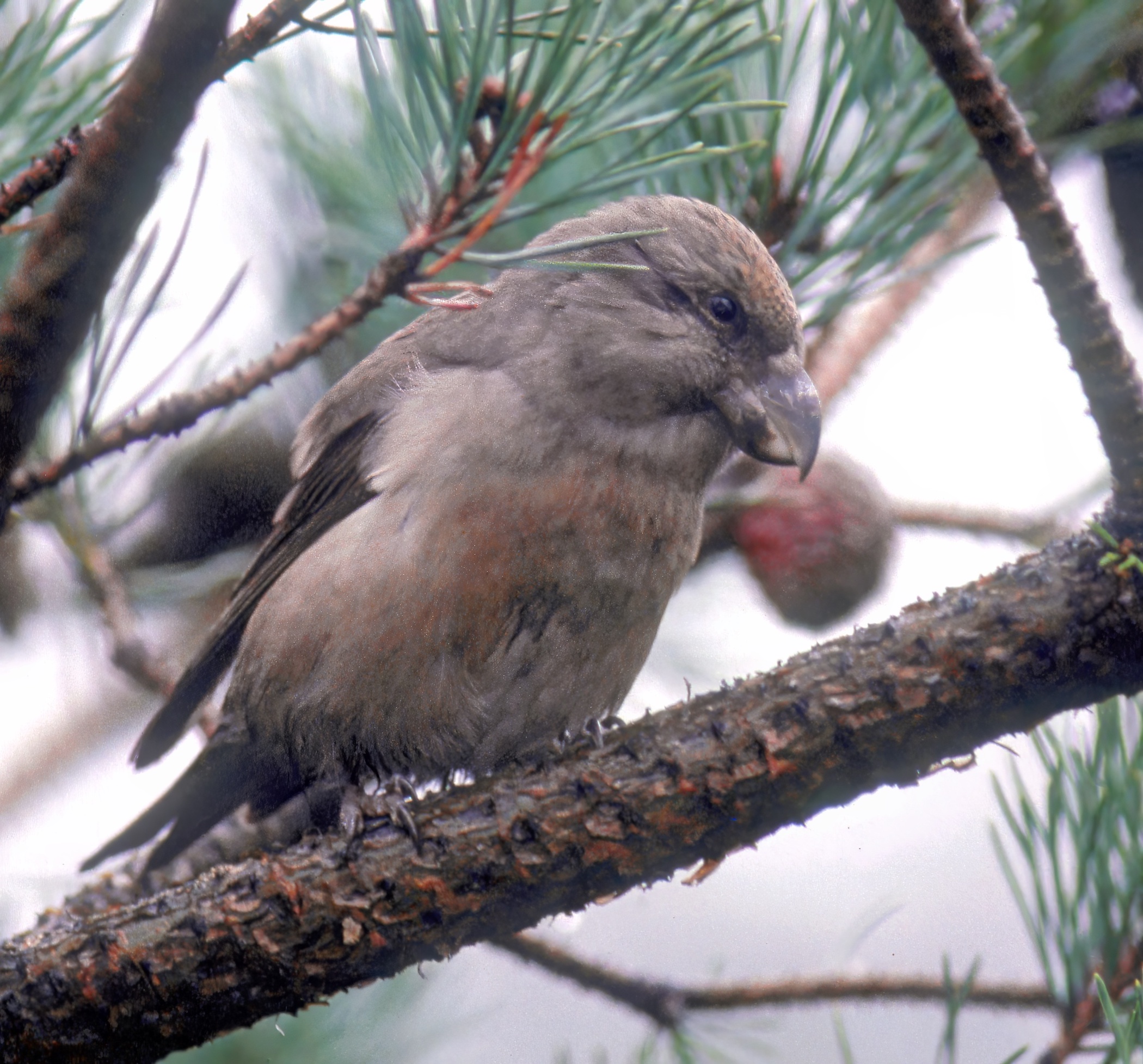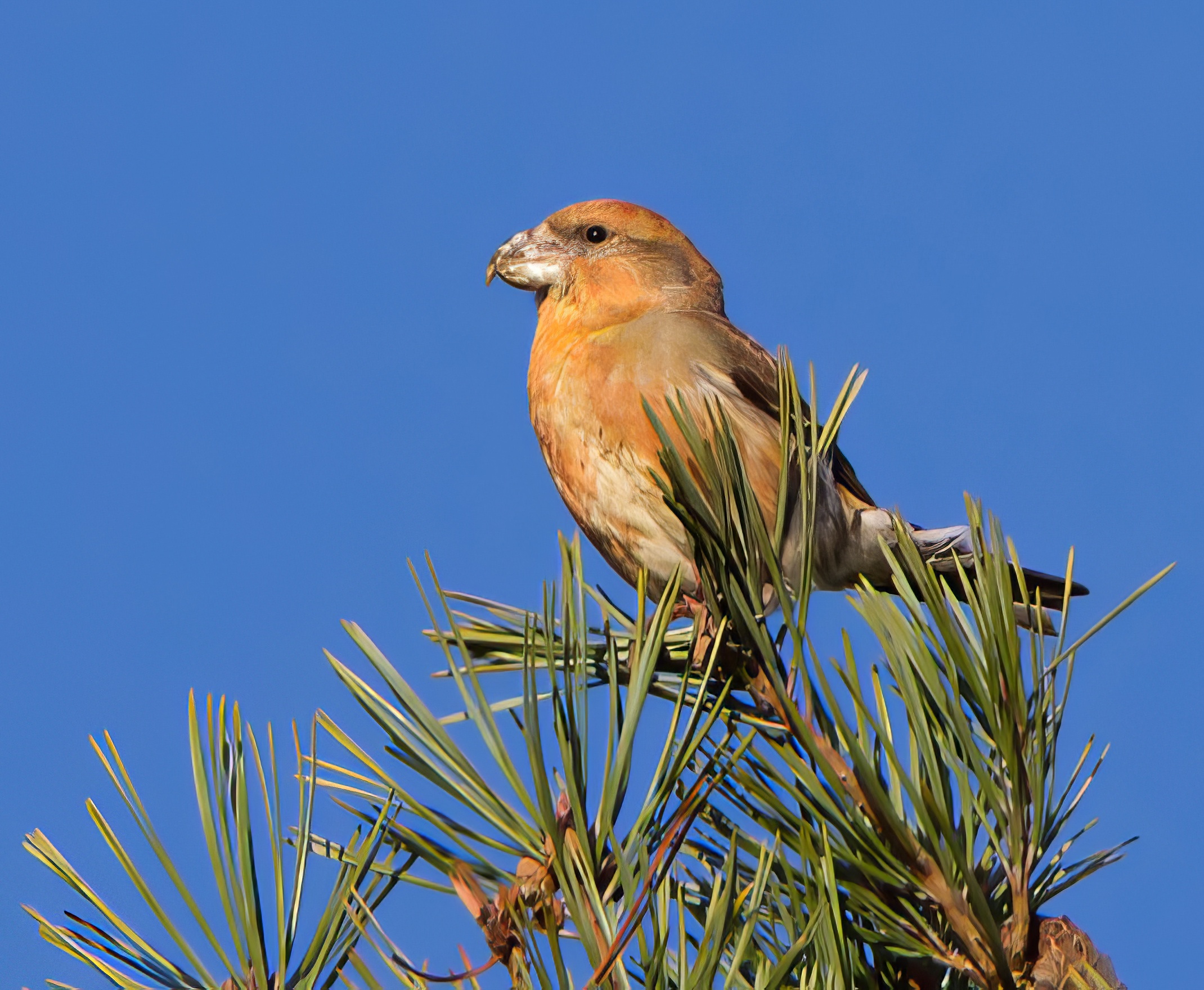Parrot Crossbill Loxia pytyopsittacus
Irruptive vagrant. Scandinavia



Parrot Crossbills: left, Humberston Fitties October 12th 1982 (Graham Catley); centre, Gibraltar Point NNR October 1990 (Unknown);
right, Chambers Farm Wood December 19th 2013 (Russ Telfer);
Catley and Hursthouse (1985) discussed the status of Parrot Crossbill in the UK and described the irruptions in the Northern Isles in September-October 1962 and 1982/83. All acceptable pre-1958 records for Britain are summarised and all of these which were dated (13 occurrences and 18 individuals) fell in the period September-March. There were no further records until a notable influx in the autumn of 1962, with subsequent winter records into 1963. The first record for Lincolnshire was trapped at Tetney on October 13th, 1962 and on January 16th 1963 the second occurred, a male found dead at Hartsholme CP. The next influx was not until 1990/91 and in Lincolnshire the first birds were found on October 18th 1990 when there were five at Donna Nook and then another five at Gibraltar Point from the following day. Barton Pits had one on October 20th. Most were recorded at conifer plantations inland where birds stayed through until mid-March 1991 with maximum counts of 35 at Kirkby Moor during November 1990-January 1st 1991, and 22 remaining until March 8th 1991. Nineteen were at Laughton Forest from December 2nd 1990-March 13th 1991 and 14 were found at Willingham Woods December 2nd 1990 with variable numbers of birds being reported from there through to January 21st 1991. The table lists the counts and dates from published records in both LBRs and BBRCs at the time, which differ slightly as specific dates were not always given. Since then, there have been only three records, in 1995, 2013 and 2018.
The immature male at Chambers Farm Wood from December 15th-20th 2013 was an early Christmas present for many. The last record, a female at Gibraltar Point on two days from November 14th-15th 2018 was the tail end of a large influx that had occurred across Britain in 2017. The pattern of occurrence of this species in the UK is highly variable as reported by White and Kehoe (2020). During the 1990s there was an average of 27 a year, heavily weighted by the 1990-91 influx, during the 2000s there were none and from 2010-18 an average of 22 per year with at least 93 birds in 2017 and 2013 also having been a good year.
| Site | First date | Last date | Count | Notes |
| Tetney | 13/10/1962 | - | 1 | Male, trapped at Low Farm, later died. |
| Hartsholme GP | 16/01/1963 | 1 | Male, found dead. | |
| Hartsholme GP | 19/01/1963 | 31/05/1963 | 2 | Male and female. |
| Hartsholme GP | 19/01/1963 | 01/02/1963 | 3 | |
| Hartsholme GP | 19/01/1963 | 26/01/1963 | 6 | |
| Hartsholme GP | 26/01/1963 | - | 9 | |
| Hartsholme GP | 15/03/1963 | - | 1 | Female, taken into care, ? shot. |
| Hartsholme GP | 17/03/1963 | - | 1 | Female, dead. |
| Humberstone Fitties | 11/10/1982 | 14/10/1982 | 1 | Male. |
| Humberstone Fitties | 12/10/1982 | 23/10/1982 | 1 | Another adult male arrived to join the bird from 11th October; this one stayed to October 23rd. |
| Grainthorpe | 12/10/1982 | 13/10/1982 | 1 | Caught, very weak, died during the night; wing 108 mm, bill length 20 mm, depth 15.5 mm, tarsus 19 mm. |
| Ingoldmells | 12/10/1982 | - | 1 | Immature male trapped, very weak, died during the night at GPBO; wing 106 mm, bill length 20.5 mm, depth 13.8 mm. |
| Donna Nook | 18/10/1990 | - | 5 | Flew south, at least one male |
| Donna Nook | 19/10/1990 | 20/10/1990 | 2 | Male and female |
| Gibraltar Point NNR | 19/10/1990 | 25/10/1990 | 3 | Male and two females |
| Gibraltar Point NNR | 26/10/1990 | - | 2 | Females, presumed same as those of 19th-25th October |
| Humberstone Fitties | 20/10/1990 | 23/10/1990 | 1 | Female |
| Kirkby Moor | 04/11/1990 | - | 4 | |
| Kirkby Moor | 11/11/1990 | 31/12/1990 | 44* | Peaks of 44 on 11/11*, 35 to 30/11, 20 to 31/12 |
| Willingham Forest | 02/12/1990 | 31/12/1990 | 14* | 14 on 2/12*, 16 on 4/12, 17 on 16/12, 9 until 31/12 at least |
| Kirkby Moor | 01/01/1991 | 08/03/1991 | 22 | |
| Willingham Forest | 01/01/1991 | 21/01/1991 | 16* | 9 to 10/1, maximum of 16 on 21/1* |
| Laughton Forest | 02/12/1990 | 13/03/1991 | 19 | 10 males 9 females |
| Laughton Forest | 08/03/1995 | - | 2 | Females |
| Chambers Farm Wood | 15/12/2013 | 20/12/2013 | 1 | Immature male with Common Crossbills |
| Gibraltar Point NNR | 14/11/2018 | 15/11/2018 | 1 | Female |
| Gibraltar Point NNR | 20/10/2020 | - | 1 | Male, unknown age, flew low south, calling, down East Dunes |
| Frampton Marsh | 28/10/2020 | - | 1 |
Finder’s report: Parrot Crossbills at Hartsholme GP, January 1963; first wintering flock in Great Britain.
by K. Atkin.
Note: this short note by Keith Atkin documents the discovery of a wintering flock of Parrot Crossbills at Hartsholme GP in January 1963. It is reproduced in it's entirety here, with permission and is © British Birds. Atkin also mentions the first confirmed county record of a male Parot Crossbill trapped at Tetney, October 13th, 1962. The tabulated 1963 records, above, most likely reflect the same birds but seen in different numbers on different dates.
On 16th January 1963 P. Prince found a dead male Parrot Crossbill Loxia pytyopsittacus in a small wood of Scots pines Pinus sylvestris at Hartsholme gravel pit, Lincoln. He visited the wood again on the 19th and located a small party of crossbills of both sexes, which he considered to be of the same species as the dead bird. Later that day he was joined by A. D. Townsend and myself, and together we had good views of about six. All had very heavy bills and we were convinced that they were Parrot Crossbills. Their main call, which we wrote as 'chup-chup', seemed deeper and louder than the corresponding note of the Crossbill L. curvirostra, though no direct comparison could be made.
On 26th January nine were counted in one tree, and this was the maximum number recorded. Subsequently the party was kept under regular observation by PP and seen by several other people. During February three or four were found on most visits and on 17th March PP discovered a partially buried female which also proved to be a Parrot Crossbill. About this time a female with an injured wing was captured and kept at a house near-by. It was thought that this and the dead birds had been shot by local youths. An abundant supply of cones ruled out any question of food shortage and on many occasions a crossbill was seen to break one off, carry it in its bill to the centre of the tree and there extract the seeds with its bill while holding the cone with one foot against a branch or the trunk. Occasionally single birds were seen feeding on fallen cones on the ground and also eating snow. At least a pair were still present until the end of May 1963 but, although the male was heard singing on several occasions, there was no evidence of breeding. The song consisted of a series of trills and twittering notes; it closely resembled that of a Greenfinch Chloris chloris but seemed more subdued. The captive female escaped during the spring and remained in the area until at least the beginning of 1964.
The measurements of the two found dead were identical except in wing-length where the male was 100 mm. and the female 99 mm.; in each case the tarsus was 20 mm., the length of the upper mandible from the feathers 20 mm. and the bill depth at the base 14.5 mm. Both identifications were confirmed by R. Wagstaffe at the City of Liverpool Museums. This appears to be the first record of a flock of Parrot Crossbills wintering in Britain. It should be remembered that in the autumn of 1962 there had been an unprecedented irruption of this species at Fair Isle and elsewhere (Bird Migration, 2: 260-264 and 329-340), during which time a male was trapped at Tetney, Lincolnshire, on 13th October 1962, which was the first record for Lincolnshire as far as we know..
Reference
(Updated with reference to the new Birds of Lincolnshire (2021) January 2023)

